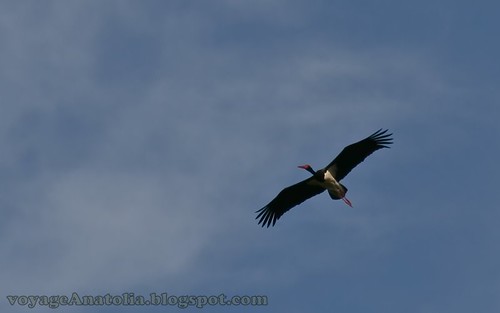
Flight of Black Stork, originally uploaded by voyageAnatolia.blogspot.com.
Black Stork Ciconia nigra flying over Köroglu Mountains near Ankara, Turkey, with flight feathers remiges open on the wingtips typical of large soaring birds allowing for the spreading of those feathers, which helps to reduce the creation of wingtip vortices, thereby reducing drag, also used in design of aircrafts.
The Black Stork is a large wading bird in the stork family Ciconiidae.
It is a widespread, but rare, species that breeds in the warmer parts of Europe, predominantly in central and eastern regions.
This is a large bird, nearly 1 m tall with a 1.8 m wingspan, weighing around 3 kilograms. It is all black except for the white belly and axillaries, and its red bill and legs. It walks slowly and steadily on the ground. Like all storks, it flies with its neck outstretched.
It breeds in large marshy wetlands with interspersed coniferous or broadlived woodlands, but also inhabits hills and mountains with sufficient network of creeks. It builds a stick nest high in trees. This is a shy and wary species, unlike the closely related White Stork.
The Black Stork, feeds on amphibians and insects.
It has a rasping call, but rarely indulges in mutual bill-clattering when adults meet at the nest.
The Black Stork is one of the species to which the Agreement on the Conservation of African-Eurasian Migratory Waterbirds (AEWA) applies.
Migration
The Black Stork is a strong migrant, wintering in tropical Africa. However, the Spanish population is resident. The Black Stork is a broad-winged soaring bird, which relies on thermals of hot air for long distance flight. Since thermals only form over land, storks, together with large raptors, must cross the Mediterranean at the narrowest points, and many Black Storks can be seen going through the Bosporus. They fly approximately 100 to 250 km a day with daily maxima up to 500 km.
Western Migration
About 10 percent of the western storks choose the passage Sicily - Cap Bon, Tunisia. The common route goes over Gibraltar. Many birds are fly around the Sahara next to the coast. Most birds are wintering in the wetlands of Nigeria or Mali.
Eastern Migration
The eastern birds take the route Bosphorus-Sinai-Nile. Birds from the Far East winter in the south of China.
The storks migrate from the middle of August to the end of September. They come back in the middle of March.